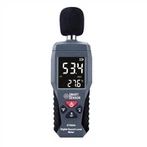Viento dirección anemómetro estudios cómo viento dirección y velocidad efecto precipitación
Con el desarrollo de la economía global, energía consumo continúa a aumento, ácido contaminante emisiones son aumentando, y el problema de ácido lluvia es convirtiéndose cada vez más grave. Personas tienen ya controladas el descarga de ácido contaminantes, pero el fenómeno de ácido lluvia todavía existe, y el daño it trae a humanidad es también aumentando día por día. Por medir la precipitación y viento dirección y velocidad en el oeste area de jiangmen zona urbana, nosotros pod entender cómo meteorología afectaciones lluvia. entre ellos, viento dirección and anemómetro son científicos instrumentos que nosotros necesitamos a usar para registrar cambios en el aire en cualquier tiempo.
According to relevant data, the maximum value of acidity weakening occurred on June 19, 2006, with a pH increase of 1.10. This precipitation lasted for 2 days, and the wind direction changed to SW on the second day. The direction of the wind in this direction was not developed in industry, and the 1.1m/s SSW wind on the first day had brought clean and humid air over the South China Sea into the inland. In addition, the precipitation on that day reached 83.4mm, and the concentration of sulfur dioxide on that day decreased by 0.015mg/L compared to the previous day. The second highest value occurred on August 22, 2005, with a pH increase of 1.08. This precipitation lasted for 7 days, which was the longest continuous precipitation in 3 years. The acidity of this precipitation fluctuated significantly; The wind speed approaches 0 on the 2nd to 6th day, at a calm wind frequency, mainly characterized by the discharge of local acidic pollutants. The temperature and pressure increase day by day, with the main upward airflow being the airflow. The continuous precipitation in the first four days has a strong washing effect on the near ground air, making it clean. On the fifth day, the precipitation suddenly increased to 33.7mm, and with an average wind speed of 0 on that day, the supplement of acidic substances in the surrounding area is limited, and the acidity of precipitation is significantly weakened; But on the 6th day, the precipitation significantly decreased, only 4.1mm. The warm and humid S-direction wind brought acidic pollutants to supplement, and coupled with the high humidity of the near ground air and strong chemical reactions, the acidity of precipitation suddenly increased by 0.81. From continuous precipitation analysis over the past three years, it can be seen that the E to SE, S, and SW direction winds with high wind speeds, especially typhoons, bring clean near ground air masses formed on the ocean surface, which will weaken the acidity of precipitation. SSE directional wind with low wind speed, conveying industrial pollution air masses upstream in this direction at close range; The ENE direction wind with high wind speed can transport industrial pollution air masses upstream for a long distance, and undergo chemical reactions with nearby air masses with high humidity along the way, enriching acidic pollutants and gradually increasing the acidity of precipitation. In addition, in meteorological measurements, we often use small meteorological stations because this instrument can measure up to 11 parameters and is comprehensive.
Meteorología es el grande ambiente nosotros vivimos en every day, such as the daily weather forecast of cloudy, sunny, rainy, windy, etc., which we can feel every day. Sin embargo, in the meteorological detection department, we need formal instruments, such as field microclimate automatic observation instruments, wind direction wind speed monitors, etc. , a específicamente detectar viento velocidad, viento dirección, temperatura, humedad, iluminación, rocío punto, y otros parámetros.






